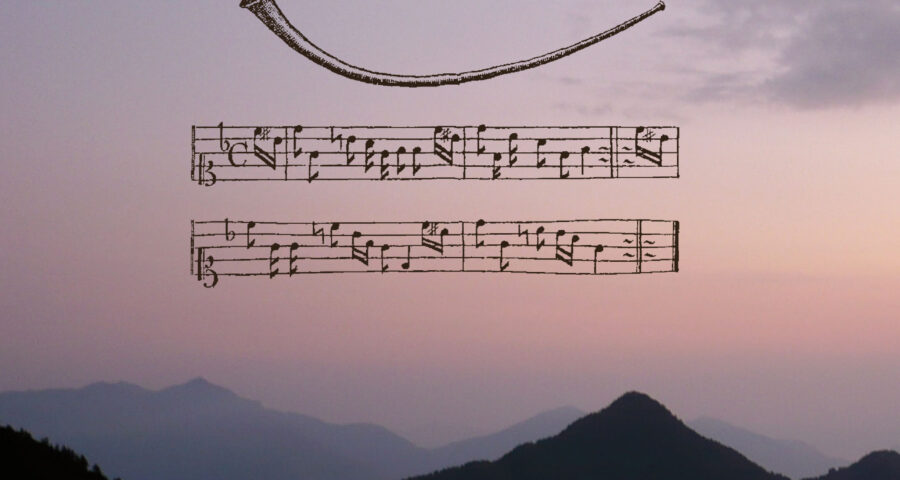Alphorn playing is sometimes described in history as “blown yodeling”, as “yodeling on the instrument”, or as “yodeling on the alphorn”. What is meant by this? On the one hand, it echoes the similar contexts in which yodeling and the alphorn were played, namely in the Alps when herding cattle and as a means of communication over long distances, but also for entertainment at festivals and competitions, such as those that took place as early as 1805 on the Unspunnen meadow in Interlaken. On the other hand, it is musical features that make the alphorn sound like a yodel. In “Alpine Vibes”, special attention is paid to these:
- Legato over large intervals and longer motifs: playing legato on the alphorn echoes the aesthetics of yodeling. In this, the alphorn differs from most other wind instruments, whose traditional music is often played rhythmically and accentuated. This does not mean that everything on the alphorn is to be played softly and legato, but this expression plays a formative role.
- Register changes between chest and head voice: Overblowing on the alphorn to jump to another natural note can correspond to the laryngeal beat in yodeling, especially when performed over large intervals.
- Such large interval leaps, which are common in yodeling but considered “unsingable” in other styles of singing, are also part of alphorn music. This is especially true for eras when horns were much shorter and could produce fewer naturals, which were also widely spaced.
- Some melodies are yodeled as well as played on the alphorn. In the case of such pieces, it is obvious that they were also sung and played by the same people and that this was also accompanied by a similar conception of sound and melodic interpretation.
- It has not yet been conclusively researched whether there is a connection between the yodel syllables for high and low registers and the sound of the alphorn – be it in its present form or in historical variants.
Despite all the connections, it can be stated that the two musical traditions can also coexist uninfluenced by each other. In practice, only the performers decide whether the alphorn is played as a blown yodel or not.
Box: Alpenstimmung – Alpine Vibes
In the Alpine region, alphorn blowing and yodeling are central musical traditions and it is impossible to imagine the cultural landscape without them. This raises questions about their musical relationship: Can alphorn blowing be considered a form of yodeling? Did the natural tone series of the alphorn influence yodel singing? Do both find their origin in the centuries-old cow rows, the melodies with which the shepherds called their cows? A research team from the Lucerne University of Applied Sciences and Arts analyzed the potential links between the two musical forms and looked for indications of a common origin. The study focused on Switzerland and extended to southern Germany and Austria. Historical and contemporary perspectives were considered. In some forms of yodeling, such as the Austrian Wurzhorner yodel, the name itself indicates a closeness to the instrument, while in the Muotatal “Bücheljuuz” the imitation of the wind instrument by the voice is so clear that the two merge in sound. But not all yodel forms have a connection to the alphorn and vice versa. The research shows a consistent, but not always constant, musical relationship between alphorn music and yodeling over the past 200 years.
Last year, the American professor emeritus Gary Martin became aware of the book “Alpenstimmung” and translated it into English under the title “Alpine Vibes”. He did the complete translation work free of charge, out of passion for the book and the alpine music culture. This commitment is unique and made the realization of the publication “Alpine Vibes” possible.
The German and English versions of the book can be obtained from Chronos-Verlag in printed form or downloaded free of charge as an e-book (pdf):
Alpenstimmung (2019, German original): Hardcover – E-Book
Alpine Vibes (2023, English translation): Hardcover – E-Book
More information about the topic:
www.hslu.ch/alphorn-jodel

Leave a Reply